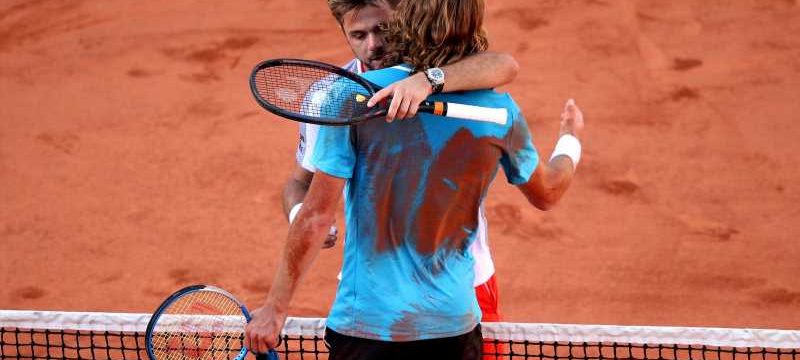Forget the semifinals, the finals, or the shiny trophy ceremonies. The sweetest spot of a tennis major is the first weekend.
By then the volume of tennis is still strong, but not, like the din of 256 singles players colliding in the early days, so overwhelming as to numb the mind. The first weekend hits before all the luck has dried up, and the ruthless selector of single-elimination has culled the youthful surprises and short-fuse weirdos. Most importantly, that weekend is the petri dish for my favorite matchup: a top player taking on some once-top player whose present seeding, for whatever reason, belies their peak abilities.
On Sunday at the French Open, those two roles could not have been more deliciously cast: Stefanos Tsitsipas, the soul-searching Greek youth now hitting his career-high of No. 6 in the world, and Stan Wawrinka, the ruddy, unpredictable troll who’s won this title before and has been slowly, unevenly returning to his old powers since knee surgery shut him down this time last year.
On paper, Wawrinka entered this tournament as the No. 24 seed, but in spirit, he must be rolled like a 20-sided die every major and seeded accordingly. He can be an easy out in straight sets or he can, as seen during his Djokovic-crushing title run here in 2014, emerge as devastating a player as has ever played, all brute force at unthinkable angles. Part of the lurid thrill of his career is that you never know when the Stanimal is coming. He’d looked pretty solid through his first three rounds. Tsitsipas had also gotten through without too many hiccups. Both looked more than capable of deep runs in Paris, but a cruel bracket demanded that one end the other’s.
The players have a telegenic one-handed backhand in common, though they use it to dramatically different ends. Wawrinka is most comfortable hanging around the baseline and hurling medicine balls back to the other baseline. Tsitsipas’s all-court mentality sends him hurtling towards the net and, inevitably, covered in clay. This court surface slows down the game for Wawrinka, affording him the time to set up his devastating strokes. For Tsitsipas, it merely complicates every net approach and softens his inevitable falls. But one of the most inspiring features of his career to date is that he plays his way every match, surface- and opponent-agnostic. Unlikely to neutralize his strengths in a moment of self-doubt, he sticks to his guns. Lucky for the viewer, it’s an explosive style to watch. Over the course of this five-hour match, the Greek played a staggering 74 points at the net, winning a healthy 67 percent of them. (For reference, Roger Federer didn’t even take that many first serves during his match earlier that day.) Wawrinka, meanwhile, is old and decorated enough to know to hang back and do damage with some of the heaviest groundstrokes in tennis history.
As a result, these two players make for a well-paired cat and mouse. The defining image of this match is a sweaty baseline exchange, with a hungry Tsitsipas pouncing on the first short ball and surging towards the net. Then the future rests in Wawrinka’s racket. His passing shot might dip cartooinishly and sneak inside the sideline—or it might be intercepted by an intrepid Tsitsipas dive. It’s a clash between Wawrinka’s huge pace and spin and the 6-foot-4 Tsitsipas’s considerable length and reflexes:
Near the end of the dogfight for the second set, those roles were reversed for one bizarro point. Wawrinka was struggling to conclude the point at the net, undone by the sun, so Tsitsipas dragged himself from corner to corner to erect a defensive wall and extend the point to ludicrous 23-stroke lengths. A point that weird deserves a winner that weird. Even without what came after, that second set alone would’ve justified price of admission. No shot seemed too grandiose to execute, and no service game was safe. The players had 17 break points between them, converting five.
What these two have in common, aside from one-handedness, is a flair for the dramatic. They whack themselves in the head a whole lot. In his signature on-court gesture, Wawrinka frequently slammed a single finger to his temple, as it to credit it for the sickening winner he’d just crushed. Tsitsipas, meanwhile, could be seen taking his palm to his forehand, hard, repeatedly, in regret. Four sets in, both men were bedaubed in sweat, clay, sunscreen, and feelings. Though Tsitsipas largely succeeds at keeping his roiling emotions in check, he let it all loose. It was only the second time in his life he’d played a five-set match, and it was about time for him to get acquainted with tennis’s most punishing journey.
And, due to the setting, there would be no clean bookend to this one. At Roland Garros, there is no fifth-set tiebreak. It’s the last major still rocking with win-by-two-games. Thus the fifth set inevitably becomes a hunt for the first break. Tsitsipas had his chances. He had eight break points in the fifth set, and converted none. Somehow the quality of play only escalated then. Wawrinka put the period on an instant classic with a ridiculous slice passing shot that nicked the sideline.
Tsitsipas, who is a prolific and diverse online poster, produced perhaps the single finest work of his second career. It’s as sustained, coherent, and revealing as he’s ever been:
For the loser, the match was an unforgettable war story. For the winner, it was a reminder that he’s not too old and banged up to escape the future greats. For Roger Federer, the day’s real winner, it was the guarantee of a depleted quarterfinal opponent.
Source: Read Full Article
